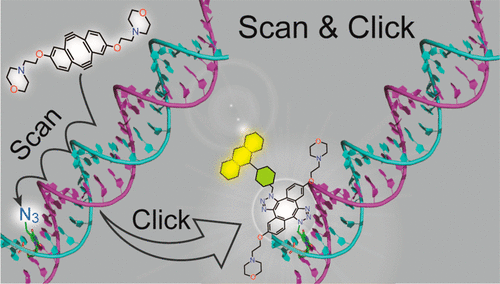当前位置:
X-MOL 学术
›
Bioconjugate Chem.
›
论文详情
Our official English website, www.x-mol.net, welcomes your
feedback! (Note: you will need to create a separate account there.)
Three-Component Bioorthogonal Reactions on Cellular DNA and RNA.
Bioconjugate Chemistry ( IF 4.0 ) Pub Date : 2019-11-13 , DOI: 10.1021/acs.bioconjchem.9b00630 Masayuki Tera 1 , Nathan W Luedtke 1
Bioconjugate Chemistry ( IF 4.0 ) Pub Date : 2019-11-13 , DOI: 10.1021/acs.bioconjchem.9b00630 Masayuki Tera 1 , Nathan W Luedtke 1
Affiliation

|
Metabolic incorporation of bioorthogonal functional groups into chromatin, followed by copper-free conjugation reactions, often gives low yields due to steric hindrance. Here we report that a cationic Sondheimer diyne derivative "DiMOC" rapidly reacts with azide groups in duplex DNA that are otherwise unreactive toward aliphatic cyclooctynes such as bicyclo[6.1.0]nonyne (BCN). DiMOC reversibly intercalates into duplex DNA and undergoes tandem strain-promoted cross-linking of two different azide groups to give DNA-DiMOC-"X" cross-links, where "X" theoretically represents a fluorescent probe, affinity tag, RNA, protein, carbohydrate, and so forth. As a proof of principle, the metabolic incorporation of azide-modified nucleosides into cellular DNA or RNA, followed by treatment with DiMOC and a fluorescent azide enabled visualization of newly synthesized nucleic acids in whole cells.
中文翻译:

细胞DNA和RNA的三组分生物正交反应。
将生物正交官能团代谢结合到染色质中,然后进行无铜偶联反应,由于空间位阻,通常收率低。在这里,我们报道阳离子Sondheimer二炔衍生物“ DiMOC”与双链DNA中的叠氮化物基团快速反应,而这些叠氮化物基团对脂族环辛炔没有反应性,例如双环[6.1.0] nonyne(BCN)。DiMOC可逆地插入双链体DNA中,并通过串联应变促进两个不同叠氮化物基团的交联,形成DNA-DiMOC-“ X”交联,其中“ X”在理论上代表荧光探针,亲和标签,RNA,蛋白质,碳水化合物等。作为原理上的证明,叠氮化物修饰的核苷在细胞DNA或RNA中的代谢整合,
更新日期:2019-11-13
中文翻译:

细胞DNA和RNA的三组分生物正交反应。
将生物正交官能团代谢结合到染色质中,然后进行无铜偶联反应,由于空间位阻,通常收率低。在这里,我们报道阳离子Sondheimer二炔衍生物“ DiMOC”与双链DNA中的叠氮化物基团快速反应,而这些叠氮化物基团对脂族环辛炔没有反应性,例如双环[6.1.0] nonyne(BCN)。DiMOC可逆地插入双链体DNA中,并通过串联应变促进两个不同叠氮化物基团的交联,形成DNA-DiMOC-“ X”交联,其中“ X”在理论上代表荧光探针,亲和标签,RNA,蛋白质,碳水化合物等。作为原理上的证明,叠氮化物修饰的核苷在细胞DNA或RNA中的代谢整合,











































 京公网安备 11010802027423号
京公网安备 11010802027423号